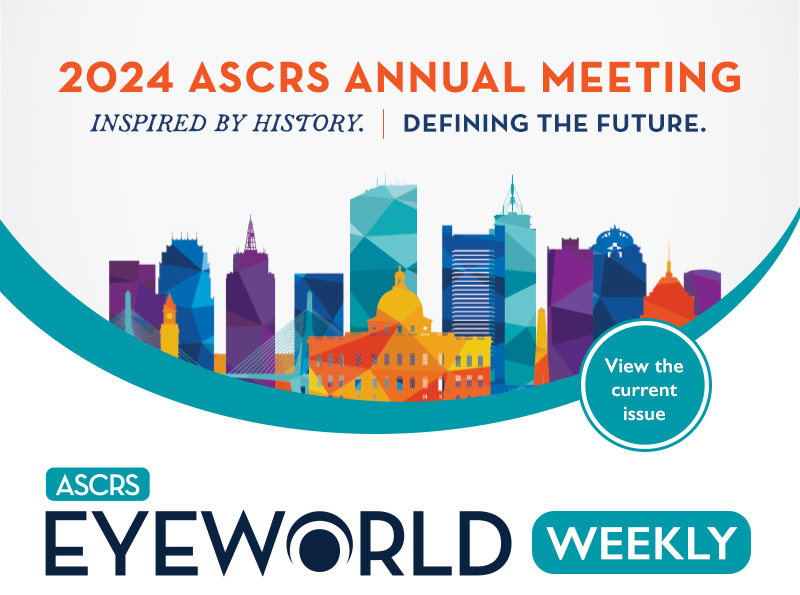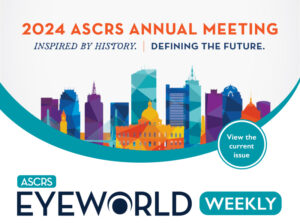
- Topline results for investigational diabetic retinopathy therapy
- Dosing complete in second cohort for Phase 1/2 trial for geographic atrophy therapy
- Large data modules launched for dry eye disease and thyroid eye disease
- Study: Real-world outcomes of MIGS combined with cataract surgery vs. cataract surgery alone
- ASCRS news and events
April 26, 2024 • Volume 30, Number 17
Topline results for investigational diabetic retinopathy therapy
Ocular Therapeutix announced topline results for its Phase 1 study investigating AXPAXLI for moderately severe to severe non-proliferative diabetic retinopathy without DME. According to the company’s press release, 46.2% of patients showed a 1- or 2-step improvement in their Diabetic Retinopathy Severity Scale (DRSS) at 40 weeks in the treatment arm compared to 0% in the sham arm. No patients in the treatment group saw worsening of the DRSS, compared to 12.5% in the control group. According to the company, AXPAXLI was well tolerated with no inflammation observed. Rescue medication was not needed in either arm. The company is planning discussions with the FDA to inform moving forward with a Phase 3 study.
Dosing complete in second cohort for Phase 1/2 trial for geographic atrophy therapy
Ocugen announced that dosing was recently completed for the second cohort participating in its Phase 1/2 clinical trial evaluating OCU410 as a modifier gene therapy for geographic atrophy. According to the company’s press release, OCU410, a subretinal injection, is designed to regulate several pathways involved in development of this advanced stage of dry AMD. The second cohort included 3 subjects who received a 200 mL medium dose (5×1010 vg/mL) of the therapy. In 4 weeks, a Data and Safety Monitoring Board will convene to review safety data before the trial proceeds with a high dose (1.5 ×1011 vg/mL) in a third cohort. According to the company, the first phase of the study is assessing safety of these increasing doses. The second phase will be randomized, outcome accessor-blinded, dose expansion where subjects will be randomized 1:1:1 to receive one of two OCU410 treatment groups or to the untreated control group.
Large data modules launched for dry eye disease and thyroid eye disease
Verana Health has announced two modules consisting of real-world data for dry eye disease and thyroid eye disease. The Qdata Dry Eye Disease module, announced earlier this month, is the largest dataset of its kind, according to Verana Health, with outcomes and clinical information on more than 10 million deidentified patients with dry eye disease. The Qdata Thyroid Eye Disease module consists of real-world data on more than 250,000 deidentified patients with thyroid eye disease. Both of these datasets can help in therapy development, monitoring treatment patterns and outcomes, and inform site selection and patient identification for studies.
Study: Real-world outcomes of MIGS combined with cataract surgery vs. cataract surgery alone
A study published in AJO International and promoted by Sight Sciences is providing real-world characteristics and outcomes of patients receiving MIGS combined with cataract surgery vs. cataract surgery alone. The ab interno MIGS options included in the study were OMNI (Sight Sciences), Hydrus (Alcon), and iStent inject (Glaukos), based on data from the IRIS Registry from July 2017 through December 2022. More than 77,000 patients with glaucoma were identified, 428 of whom received OMNI, 1,436 Hydrus, and 4,769 iStent inject in combination with cataract surgery; 70,759 had cataract surgery alone. Patients whose baseline IOP was more than 18 mm Hg saw a significant decrease in IOP when cataract surgery was combined with MIGS (OMNI: –6.64, Hydrus: –5.71, iStent inject: –4.96) vs. cataract surgery alone (–5.55), as well as a decrease in IOP-lowering medications (OMNI: –1.34, Hydrus: –1.20, iStent Inject: –0.86) vs. those who had cataract surgery alone (–0.67) at 24 months. Patients whose baseline IOP was 18 mm Hg or less and received cataract surgery plus MIGS or cataract surgery alone had a significant medication reduction but no change in IOP, according to the paper. The investigators wrote, “as MIGS procedures lead to non-equivalent results, further research will define the role of each in patient subpopulations.”
ASCRS news and events
- ASCRS Annual Meeting: Hotel blocks are open for the 2025 ASCRS Annual Meeting in Los Angeles, California, April 25–28, 2025. EyeWorld Online Exclusives featuring coverage from the 2024 meeting have begun being posted—find them here.
- ASCRS Live!: This new dinner series, making its way to nine cities, is continuing to bring ASCRS education around the U.S. See where it’s heading next.
- ASCRS 50th Anniversary: Review historical videos, watch member accounts, and scroll through the timeline—all brought together on these webpages to celebrate the Society’s historic anniversary.
Research highlights
- The effect of decreased illumination on rate of postop visual recovery and incidence of CME using a traditional analog operating microscope compared to a 3D visualization system was evaluated in a prospective, randomized, consecutive, single-surgeon series published in the Journal of Cataract & Refractive Surgery. Patients were randomized to either have cataract surgery at the traditional operating microscope (the traditional group) or the 3D visualization system attached to the same traditional operating microscope (digital group). Light intensity, light exposure time, cumulative dissipated energy, if femtosecond laser was used, and other parameters were recorded. In total, there were 118 eyes in the traditional group and 96 in the digital group. There were no differences in preop visual acuity, light exposure time, CDE, or femtosecond laser use. Light intensity was significantly less in the digital group (19.5%±0.5%) compared to the traditional group (48.6%±0.6%). The authors noted that the digital group had a better decimal postop day 1 visual acuity with less CME compared to the traditional group. “Visual recovery and CME rates were significantly better in patients who underwent cataract surgery assisted by the 3D digital visualization platform without an increase in complications or surgical time,” the authors concluded.
- A study published in the journal Clinical Ophthalmology sought to evaluate the amount of residual ophthalmic viscosurgical device in a simulated cataract surgery situation among five different single-piece IOLs and a three-piece IOL. The study authors wrote that cataract surgery was performed in pig eyes using ophthalmic viscosurgical device labeled with fluorescent silica particles. After the surgery, which included typical ophthalmic viscosurgical device removal, the fluorescent silica still attached to the IOL could be observed and quantified after IOL explantation. The researchers found that the amount and distribution of residual ophthalmic viscosurgical device differed among the different types of lenses. The authors concluded that the behavior of the IOL within the capsule affected the residual tendency and stated that “removal of ophthalmic viscosurgical device in the lens capsule should be tailored for each intraocular lens to improve efficiency.”
This issue of EyeWorld Weekly was edited by Stacy Jablonski, Liz Hillman, and Ellen Stodola.
EyeWorld Weekly (ISSN 1089-0319), a digital publication of the American Society of Cataract and Refractive Surgery (ASCRS), is published every Friday, distributed by email, and posted live on Friday.
Medical Editors: Sumit “Sam” Garg, MD, Chief Medical Editor, Mitchell Weikert, MD, Cataract Editor, Karolinne Rocha, MD, PhD, Refractive Editor, Julie Schallhorn, MD, Cornea Editor, Manjool Shah, MD, Glaucoma Editor
For sponsorship opportunities or membership information, contact: ASCRS • 12587 Fair Lakes Circle • Suite 348 • Fairfax, VA 22033 • Phone: 703-591-2220 • Fax: 703-591-0614 • Email: ascrs@ascrs.org
Mention of products or services in EyeWorld Weekly does not constitute an endorsement by ASCRS.
Click here to view our Legal Notice.
Copyright 2024, EyeWorld News Service. All rights reserved.


